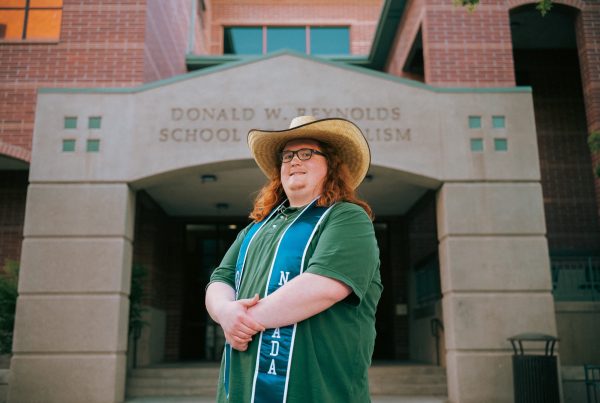Whispers of a huge freeze in the University of Nevada Reno’s hiring process have run amok across the campus departments. Unfortunately for faculty, staff and students at the university, what they’re likely hearing is true due to a large budget deficit.
There are currently 108 vacant positions – and more to be discovered – that are frozen, said Andrew Clinger, vice president of administration and finance.
The budget deficit is partially due to the state underfunding the mandated cost of living adjustments for classified and professional staff at all Nevada System of Higher Education institutions. Unfortunately the NSHE institutions, like UNR, are forced to fill in the money gaps.
First, let’s start with the numbers of the current fiscal year:
FY 2024 shortfall = $25.4 M
Why?
- Cost of 12% COLA for Faculty & Staff: $27.1M
- 60.5% State COLA Funding Allocation: $16.4M
- 12% COLA Funding Shortfall: $10.7M
- Lower than Projected Enrollment: $8.5M
- Net Increase in Expenses: $1.7M
- Projected Utility Shortfall: $4.5M
- Net FY 24 Shortfall: $25.4M
UNR’s Solutions to FY 2024:
- 5% Budget Reductions: $11.1M
- Reallocation of F&A Funds: $5.0M
- Administrative Overhead Charge: $5.0M
- Anticipated Vacancy Savings: $5.0M
Total: $26.1M
The five percent reductions are across these units:
- President’s Office = $204,000
- Provost’s Office = $585,000
- Administration & Finance = $1,346,000
- Student Services = $198,000
- Advancement = $295,000
- Athletics = $830,000
- CABNR = $425,000
- College of Business = $754,000
- College of Education = $489,000
- College of Engineering = $1,137,000
- College of Liberal Arts = $1,852,000
- College of Science = $1,074,000
- Graduate School = $144,000
- Honors College = $38,000
- Journalism = $150,000
- Libraries = $549,000
- Research & Innovation = $194,000
- School of Medicine = $69,000
- School of Nursing = $197,000
- School of Public Health = $387,000
- School of Social Work = $107,000
The lower enrollment and increases in COLAs caused a budget shortfall in this fiscal year. However, there is another COLA coming in 2025 that is underfunded by the state and will require an increase in student fees.
The Nevada Sagebrush is to include the projections given regarding fiscal year 2025, but first, let’s discuss how this happened.
How did we get here?
The underfunded COLAs hold a large chunk of why the shortfall occurs, but it is not the only reason.
The university and other institutions have faced declining enrollment numbers, which caused a loss in roughly 8.5 million dollars of the fund – a hefty chip off this shortfall.
Kent Ervin, a member of the Nevada Faculty Alliance, wrote an eight-part series detailing the other matters affecting the budget deficit in addition to the COLAs. For example, the goal to boost the athletics budget up 10 million dollars, increases in high-paid executive administration positions, funding toward projects like the new College of Business building, the extra iPad funds and a diversion of student fees for other programs besides the instructional learning.
However, let’s focus on the COLAs, since they have been the recent burst of talk and contribute to a large chunk of the shortfall.
The history of COLAs
Pre-2023 legislative session:
Cost of living adjustments are exactly what they sound like — a change in the income or benefits people receive to “adjust” to new increased costs of everyday living. Usually, these are put forward to counteract the harsh effects of inflation.
Before 2019, the Nevada System of Higher Education’s Board of Regents allocated 80 percent funding for any recommended COLA. However, after the 2019 session of the Nevada State Legislature, NSHE’s COLA funding was reduced from 80 percent to 64 percent — hence the new wave of underfunding COLAs for the university.
The remainder of the money needed to supply the budget and the COLAs would originate from student fees and tuition due to the 2021 legislative session’s new budget policy. Assembly Bill 493 established that the COLAs for NSHE budgets would be funded only with the portion of the budgets funded by state-supported appropriations, which was roughly 63 percent. During this session, they approved increases in salaries for both classified and professional employees of approximately 1% for fiscal year 2023.
Essentially, AB 522 stated COLAs were only going to be funded from the state-portion of the budget. This means the money comes from the portion the state dedicates to the COLAs. The only other source to make up this funding in the state-supported budget is by retrieving more revenue from student tuition fees. This means COLAs would have to rely proportionally on student fees.
Amy Stephenson, head of the governor’s finance office, sent a letter to Marilyn Dondero Loop, Las Vegas senator in the Nevada State Senate, on behalf of Joe Lombardo, governor of Nevada, to change the policy and restore the 80 percent salary coverage of COLAs.
However, during the 2023 session, the policy was not changed and only the approximate 65 percent remained for COLA coverage.
May 26, 2023:
During Nevada’s 2023 legislative session, AB522 was issued and approved on the senate floor on May 26. The governor signed the bill on July 1.
AB522, a bill passed to include different public employees, budgeted a 12 percent cost of living adjustment for the 2024 fiscal year and another up to 11 percent increase for faculty in fiscal year 2025. This bill included many state worker positions, including classified staff across the entire Nevada System of Higher Education.
This is not the same situation for faculty across the NSHE. The bill states an increase for “professional employees” salaries and the requirements are “not to exceed” 12 percent for fiscal year 2024 and “not to exceed” 4 and 7 percent for the 2025 fiscal year. The bill does not mandate that they receive a 12 percent addition. The Board of Regents of the NSHE decides if they want to issue the final percentage of the COLA. The classified workers 12 percent is fixed and determined by the bill only.
The 12 percent increase for fiscal year 2024 has already been put into place. The NSHE Board of Regents was to decide if the 2025 fiscal year would include the 11 percent increase or if they would lower this percentage.
As explained above, the legislature had funded 80 percent of the COLAs, but starting in 2019, this number dropped to 64 percent.
This year, the legislature appropriated 65.74 percent of the dollars necessary to fully fund this COLA increase. This meant the Board of Regents had to plan on how to fund the rest of the COLA for each of their institutions. This usually means budget cuts across the educational realm, as well as increases in student tuition.
Nov. 16, 2023:
At the faculty senate meeting on Nov. 16, Clinger, the vice president for administration and finance, gave a brief overview on the fiscal year 2024 cuts as a result of the already approved 2024 COLA. Clinger also gave a projection of fiscal year 2025 options if the new COLA is approved by the board.
According to Clinger, the shortfall projections for fiscal year 2025 looks like this:
FY 25 Budget Shortfall:
- 12% COLA Funding Shortfall: $10.7M
- 11% COLA Funding Shortfall: $11.0M
- Lower than Projected Enrollment: $10M
- Net FY 25 Shortfall: $31.7M
Since the COLAs are only being funded by the state appropriations budget, when the COLAs rise — which is needed for current inflation issues — and the funding from the state goes down, there is a necessary increase in student tuition fees to break even on this cost.
But why such a large COLA raise?
According to the state’s final executive budget summary for fiscal year 2024 to 2025, the money would “restore” the COVID-cuts of 74.8 million dollars towards NSHE institutions. State public officials have not received an 11 percent raise since 1985 and actually received a 2.5 percent cut in salary in 2021, which was restored in 2022.
Kent Ervin, former president of the NFA, created a chart outlining specifically, the NSHE faculties’ net relative salaries in dollars, with fiscal year 2009 being the 100 percent starting highest salary. Fiscal year 2025, even with the 11 percent COLA boost, puts faculty just shy of 90 percent, which is the same as their 2015 rates as adjusted by cost of living increases.
The article also mentions the average UNLV and UNR’s academic salaries are 23 percent lower than their western peers at R1 research universities, according to this year’s American Association of University Professors Faculty Compensation Survey.
Basically, in order to adjust to the large cost of living increases in the state, this percentage jump was necessary to maintain typical staff wage levels.
The results for what fiscal year 2025 will look like
Dec. 1, 2023:
The Board of Regents discussed what the COLA adjustments would be at their quarterly meeting bright and early on Dec. 1. At the start, there were long hours of public comment from faculty and students across the NSHE institutions, mostly discussing the COLA funding plan.
These were the two options for COLAs and student fees written on the agenda:
Option A:
- Award the 11 percent increase to the salary for NSHE professional employees for fiscal year 2025 with a delayed implementation date of Oct. 1, 2024
- Approval of a five percent increase in NSHE student registration fees, non-resident tuition, part-time non-resident tuition and distance education tuition
- AND 15 percent of the increased fee for the universities and upper-division community colleges
- AND 10 percent of the increased fee for the community colleges to be dedicated to student access, consistent with Board policy and the remainder used exclusively in support of the salary increase to the state supported operating budget
Option B:
- Award a 9.5 percent salary increase for all professional employees for fiscal year 2025, effective July 1, 2024.
- Approve a five percent increase in NSHE student registration fees, non-resident tuition, part-time non-resident tuition, and distance education tuition
- AND 15 percent of the increased fee for the universities and upper division community colleges
- AND 10 percent of the increased fee for the community colleges will be dedicated to student access, consistent with Board policy, and the remainder used exclusively in support of the salary increase to the state supported operating budget
Most public commenters were supporting the student fee increase and the COLA delay, including Sandoval, the president of the university, who also expressed his support for option A.
The Board of Regents voted unanimously on “Option A,” agreeing to raise tuition and fees by five percent to help pay for the 11 percent COLA and delay it until October 1, 2024.
We already saw projections of how this COLA would affect fiscal year 2025 for the university from Clinger’s numbers, but the aftermath of the actual situation for students and faculty may be harder than expected.
How has this already affected students?
Have you noticed more classes being closed, professors leaving the universities and a lack of other department additions?
The English department, for example, canceled a handful of courses for the semester because classes couldn’t be maintained if they were too small or professors couldn’t be found to fill the courses — this included “Professional Editing and Publishing,” “Strategies for Responding to Writing and Writers,” and “English Drama to 1642.”
How are students supposed to stay on track for graduation if the course opportunities are growing smaller and the class sizes are growing too big for students to enroll in what they need?
The lingering aftermath of the hiring freeze and department cuts across the board has affected the amount of course options for students and added to the disappearing faculty positions — either from remaining empty from the hiring freeze or from extra faculty that can be “let go” as they are not necessary. There also could be potential student enrollment issues now that college just got a little bit more expensive for incoming students.
Students are going to ask themselves why they should pay more only to have less course options they are interested in available to them.
When the Nevada Sagebrush posted a poll in their Instagram, there were responses about students feeling like there were “limited class options” for their majors and “limited time slots” for classes that may only have one professor option.
As students wait for this increase in student fees to sink their pockets, the awareness of less professors and less interesting course options may start to affect their decision to stay enrolled at the university.
More coverage on the budget will be coming soon as the Sagebrush continues to engage with faculty, students and the administration.
Jaedyn Young can be reached at jaedynyoung@sagebrush.unr.edu or on Twitter @jaedyn_young3.









